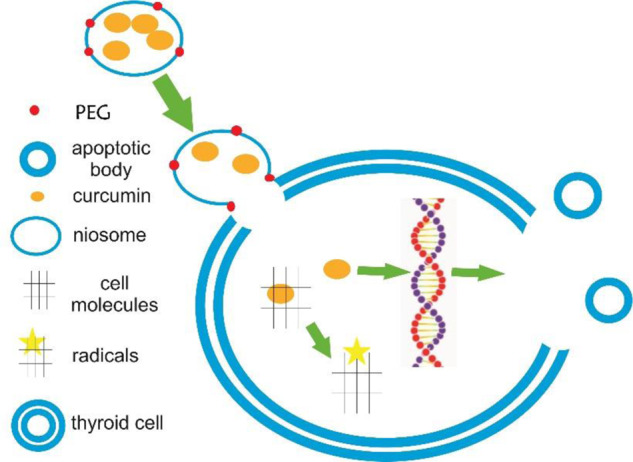- Record: found
- Abstract: found
- Article: found
Polyethylene glycol triggers the anti-cancer impact of curcumin nanoparticles in sw-1736 thyroid cancer cells

Read this article at
Abstract
Curcumin has been recognized as an effective anticancer agent. However, due to its hydrophobic property, the cell absorption is not satisfied. Herein, the curcumin nanoparticles were prepared in the presence of polyethylene glycol 6000 (PEG6000) to reduce its elimination by immune system. For first time, not only the curcumin was encapsulated within the niosome nanoparticles modified by PEG, there are no reports related to the anticancer property of curcumin against thyroid cancers. The nanoparticles was developed and its anticancer was studied on sw-1736 cancer cell line. The nanoparticles were examined by scanning electron microscopy (SEM) and dynamic light scattering (DLS). Also, the release profile of curcumin, the IC50 concentration, the radical amount and the gene expression were evaluated. The optimized nanoparticles showed a diameter of 212 ± 31 nm by SEM and the encapsulation efficiency and loading capacity of 76% and 16.8% respectively. DLS confirmed the polydispersity index (PDI) of 0.596 and the release model was shown a sustained release with the delivery of 68% curcumin after 6 days. Also, the nanoparticles indicated the higher storage stability at 4 °C. After the cell treatment, the apoptotic bodies were appeared and IC50 was obtained as 0.159 mM. Moreover, the generated radicals by the treated cells was 86% after 72 h and the gene pattern indicated the bax/bcl2 ratio of 6.83 confirming the apoptosis effect of the nanoparticles. The results approved the nanoparticles could be suggested as an anticancer drug candidate for thyroid cancers.

The encapsulated curcumin within the niosome nanoparticles modified with PEG, could be released and up-taken by the thyroid cancer cell line due to the same hydrophobic property of cell membrane and the niosome particles. The reaction between curcumin and cellular components generates radicals and activates the apoptotic pathway. The corresponding reaction finally makes cell death.
Related collections
Most cited references93
- Record: found
- Abstract: found
- Article: not found
Global Cancer Statistics 2018: GLOBOCAN Estimates of Incidence and Mortality Worldwide for 36 Cancers in 185 Countries
- Record: found
- Abstract: found
- Article: not found
Cancer statistics, 2019

- Record: found
- Abstract: found
- Article: found